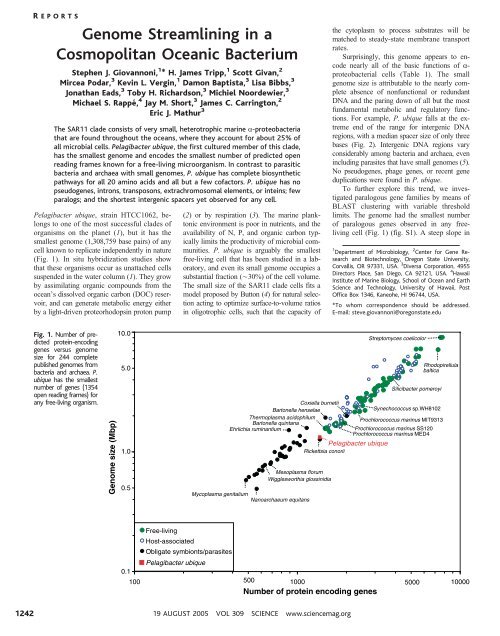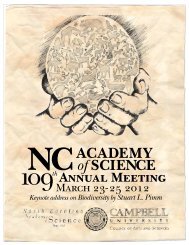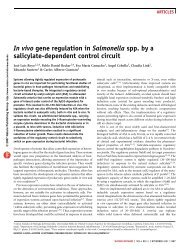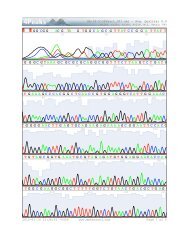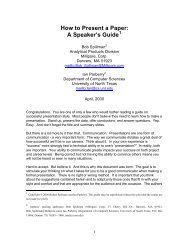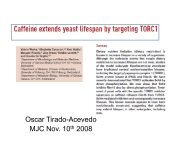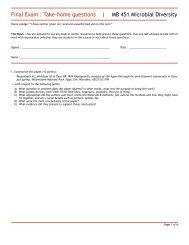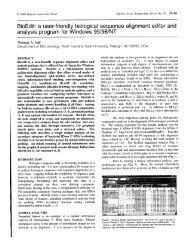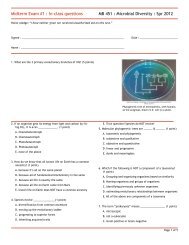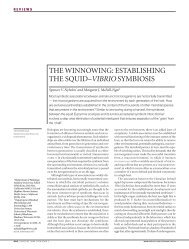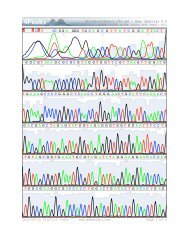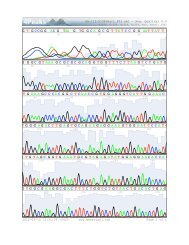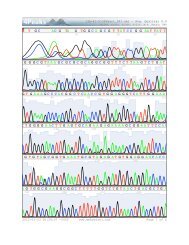Genome Streamlining in a Cosmopolitan Oceanic Bacterium - Science
Genome Streamlining in a Cosmopolitan Oceanic Bacterium - Science
Genome Streamlining in a Cosmopolitan Oceanic Bacterium - Science
You also want an ePaper? Increase the reach of your titles
YUMPU automatically turns print PDFs into web optimized ePapers that Google loves.
R EPORTS<br />
<strong>Genome</strong> <strong>Streaml<strong>in</strong><strong>in</strong>g</strong> <strong>in</strong> a<br />
<strong>Cosmopolitan</strong> <strong>Oceanic</strong> <strong>Bacterium</strong><br />
Stephen J. Giovannoni, 1 * H. James Tripp, 1 Scott Givan, 2<br />
Mircea Podar, 3 Kev<strong>in</strong> L. Verg<strong>in</strong>, 1 Damon Baptista, 3 Lisa Bibbs, 3<br />
Jonathan Eads, 3 Toby H. Richardson, 3 Michiel Noordewier, 3<br />
Michael S. Rappé, 4 Jay M. Short, 3 James C. Carr<strong>in</strong>gton, 2<br />
Eric J. Mathur 3<br />
The SAR11 clade consists of very small, heterotrophic mar<strong>in</strong>e a-proteobacteria<br />
that are found throughout the oceans, where they account for about 25% of<br />
all microbial cells. Pelagibacter ubique, the first cultured member of this clade,<br />
has the smallest genome and encodes the smallest number of predicted open<br />
read<strong>in</strong>g frames known for a free-liv<strong>in</strong>g microorganism. In contrast to parasitic<br />
bacteria and archaea with small genomes, P. ubique has complete biosynthetic<br />
pathways for all 20 am<strong>in</strong>o acids and all but a few cofactors. P. ubique has no<br />
pseudogenes, <strong>in</strong>trons, transposons, extrachromosomal elements, or <strong>in</strong>te<strong>in</strong>s; few<br />
paralogs; and the shortest <strong>in</strong>tergenic spacers yet observed for any cell.<br />
Pelagibacter ubique, stra<strong>in</strong> HTCC1062, belongs<br />
to one of the most successful clades of<br />
organisms on the planet (1), but it has the<br />
smallest genome (1,308,759 base pairs) of any<br />
cell known to replicate <strong>in</strong>dependently <strong>in</strong> nature<br />
(Fig. 1). In situ hybridization studies show<br />
that these organisms occur as unattached cells<br />
suspended <strong>in</strong> the water column (1). They grow<br />
by assimilat<strong>in</strong>g organic compounds from the<br />
ocean_s dissolved organic carbon (DOC) reservoir,<br />
and can generate metabolic energy either<br />
by a light-driven proteorhodops<strong>in</strong> proton pump<br />
(2) or by respiration (3).Themar<strong>in</strong>eplanktonic<br />
environment is poor <strong>in</strong> nutrients, and the<br />
availability of N, P, and organic carbon typically<br />
limits the productivity of microbial communities.<br />
P. ubique is arguably the smallest<br />
free-liv<strong>in</strong>g cell that has been studied <strong>in</strong> a laboratory,<br />
and even its small genome occupies a<br />
substantial fraction (È30%) of the cell volume.<br />
ThesmallsizeoftheSAR11cladecellsfitsa<br />
model proposed by Button (4) for natural selection<br />
act<strong>in</strong>g to optimize surface-to-volume ratios<br />
<strong>in</strong> oligotrophic cells, such that the capacity of<br />
the cytoplasm to process substrates will be<br />
matched to steady-state membrane transport<br />
rates.<br />
Surpris<strong>in</strong>gly, this genome appears to encode<br />
nearly all of the basic functions of a-<br />
proteobacterial cells (Table 1). The small<br />
genome size is attributable to the nearly complete<br />
absence of nonfunctional or redundant<br />
DNA and the par<strong>in</strong>g down of all but the most<br />
fundamental metabolic and regulatory functions.<br />
For example, P. ubique falls at the extreme<br />
end of the range for <strong>in</strong>tergenic DNA<br />
regions, with a median spacer size of only three<br />
bases (Fig. 2). Intergenic DNA regions vary<br />
considerably among bacteria and archaea, even<br />
<strong>in</strong>clud<strong>in</strong>g parasites that have small genomes (5).<br />
No pseudogenes, phage genes, or recent gene<br />
duplications were found <strong>in</strong> P. ubique.<br />
To further explore this trend, we <strong>in</strong>vestigated<br />
paralogous gene families by means of<br />
BLAST cluster<strong>in</strong>g with variable threshold<br />
limits. The genome had the smallest number<br />
of paralogous genes observed <strong>in</strong> any freeliv<strong>in</strong>g<br />
cell (Fig. 1) (fig. S1). A steep slope <strong>in</strong><br />
1 Department of Microbiology,<br />
2 Center for Gene Research<br />
and Biotechnology, Oregon State University,<br />
Corvallis, OR 97331, USA. 3 Diversa Corporation, 4955<br />
Directors Place, San Diego, CA 92121, USA.<br />
4 Hawaii<br />
Institute of Mar<strong>in</strong>e Biology, School of Ocean and Earth<br />
<strong>Science</strong> and Technology, University of Hawaii, Post<br />
Office Box 1346, Kaneohe, HI 96744, USA.<br />
*To whom correspondence should be addressed.<br />
E-mail: steve.giovannoni@oregonstate.edu<br />
Fig. 1. Number of predicted<br />
prote<strong>in</strong>-encod<strong>in</strong>g<br />
genes versus genome<br />
size for 244 complete<br />
published genomes from<br />
bacteria and archaea. P.<br />
ubique has the smallest<br />
number of genes (1354<br />
open read<strong>in</strong>g frames) for<br />
any free-liv<strong>in</strong>g organism.<br />
<strong>Genome</strong> size (Mbp)<br />
10.0<br />
5.0<br />
1.0<br />
0.5<br />
Coxiella burnetii<br />
Bartonella henselae<br />
Thermoplasma acidophilum<br />
Bartonella qu<strong>in</strong>tana<br />
Ehrlichia rum<strong>in</strong>antium<br />
Mesoplasma florum<br />
Wigglesworthia gloss<strong>in</strong>idia<br />
Mycoplasma genitalium<br />
Nanoarchaeum equitans<br />
Pelagibacter ubique<br />
Rickettsia conorii<br />
Streptomyces coelicolor<br />
Silicibacter pomeroyi<br />
Prochlorococcus mar<strong>in</strong>us SS120<br />
Prochlorococcus mar<strong>in</strong>us MED4<br />
Rhodopirellula<br />
baltica<br />
Synechococcus sp.WH8102<br />
Prochlorococcus mar<strong>in</strong>us MIT9313<br />
Free-liv<strong>in</strong>g<br />
Host-associated<br />
Obligate symbionts/parasites<br />
Pelagibacter ubique<br />
0.1<br />
100 500 1000 5000 10000<br />
Number of prote<strong>in</strong> encod<strong>in</strong>g genes<br />
1242<br />
19 AUGUST 2005 VOL 309 SCIENCE www.sciencemag.org
the decl<strong>in</strong>e of potential paralogs with <strong>in</strong>creas<strong>in</strong>g<br />
gene pairwise similarity threshold, relative<br />
to other organisms, suggested that the few<br />
paralogs present <strong>in</strong> P. ubique are descended<br />
from relatively old duplication events, and that<br />
steady evolutionary pressure has constra<strong>in</strong>ed the<br />
expansion of gene families <strong>in</strong> this organism (fig.<br />
S2). Furthermore, there was no evidence of<br />
DNA orig<strong>in</strong>at<strong>in</strong>g from recent horizontal gene<br />
transfer events. The presence of DNA uptake<br />
and competence genes (PilC, PilD, PilE, PilF,<br />
PilG, PilQ, comL, andc<strong>in</strong>A) <strong>in</strong> the genome<br />
suggests that P. ubique has the ability to acquire<br />
foreign DNA. These data are consistent with<br />
the hypothesis that cells <strong>in</strong> some ecosystems<br />
are subject to powerful selection to m<strong>in</strong>imize<br />
the material costs of cellular replication; this<br />
concept is known as streaml<strong>in</strong><strong>in</strong>g (5).<br />
Several hypotheses have been used to expla<strong>in</strong><br />
genome reduction <strong>in</strong> prokaryotes, particularly<br />
<strong>in</strong> parasites, which have the smallest<br />
cellular genomes known. The relaxation of positive<br />
selection for genes used <strong>in</strong> the biosynthesis<br />
of compounds that can be imported from the<br />
host, together with a bias favor<strong>in</strong>g deletions<br />
over <strong>in</strong>sertions <strong>in</strong> most or all bacteria, appear to<br />
account for genome reduction <strong>in</strong> many parasites<br />
and organelles (5). The streaml<strong>in</strong><strong>in</strong>g hypothesis<br />
assumes that selection acts to reduce genome<br />
size because of the metabolic burden of replicat<strong>in</strong>g<br />
DNA with no adaptive value. Under this<br />
hypothesis, it is presumed that repetitive DNA<br />
arises when mechanisms that add DNA to<br />
genomes—for example, recomb<strong>in</strong>ation and<br />
the propagation of self-replicat<strong>in</strong>g DNA (e.g.,<br />
<strong>in</strong>trons, <strong>in</strong>te<strong>in</strong>s, and transposons)—overwhelm<br />
the simple economics of metabolic costs.<br />
However, evolutionary theory predicts that<br />
the probability that selection will act to<br />
elim<strong>in</strong>ate DNA merely because of the metabolic<br />
cost of its synthesis will be greatest <strong>in</strong><br />
very large populations of cells that do not experience<br />
drastic periodic decl<strong>in</strong>es (6).<br />
Table 1. Metabolic pathways <strong>in</strong> Pelagibacter.<br />
Pathway<br />
Glycolysis<br />
TCA cycle<br />
Glyoxylate shunt<br />
Respiration<br />
Pentose phosphate cycle<br />
Fatty acid biosynthesis<br />
Cell wall biosynthesis<br />
Biosynthesis of all 20 am<strong>in</strong>o acids<br />
Heme biosynthesis<br />
Ubiqu<strong>in</strong>one<br />
Nicot<strong>in</strong>ate and nicot<strong>in</strong>amide<br />
Folate<br />
Riboflav<strong>in</strong><br />
Pantothenate<br />
B 6<br />
Thiam<strong>in</strong>e<br />
Biot<strong>in</strong><br />
B 12<br />
Ret<strong>in</strong>al<br />
Prediction<br />
Uncerta<strong>in</strong><br />
Present<br />
Present<br />
Present<br />
Present<br />
Present<br />
Present<br />
Present<br />
Present<br />
Present<br />
Present<br />
Present<br />
Present<br />
Absent<br />
Absent<br />
Absent<br />
Absent<br />
Absent<br />
Present<br />
The streaml<strong>in</strong><strong>in</strong>g hypothesis has been used<br />
to expla<strong>in</strong> genome reduction <strong>in</strong> Prochlorococcus,<br />
a photoautotroph that reaches population<br />
sizes <strong>in</strong> the oceans that are similar to<br />
those of Pelagibacter (7–9). Prochlorococcus<br />
genomes range from 1.66 to 2.41 million base<br />
pairs (Mbp). Many organisms with reduced<br />
genomes, <strong>in</strong>clud<strong>in</strong>g some pathogens, also have<br />
very low G:C to A:T ratios (10) (fig. S3),<br />
which can be attributed to biases <strong>in</strong> mutational<br />
frequencies, but alternatively might convey a<br />
selective advantage by lower<strong>in</strong>g the nitrogen<br />
requirement for DNA synthesis, thereby reduc<strong>in</strong>g<br />
the cellular requirement for fixed forms<br />
of nitrogen (7). N and P are both proportionately<br />
important constituents of DNA that are<br />
frequently limit<strong>in</strong>g <strong>in</strong> seawater. The P. ubique<br />
genome is 29.7% GþC. Of four complete Prochlorococcus<br />
genome sequences, the two that<br />
lack the DNA repair enzyme 6-0-methylguan<strong>in</strong>e-<br />
DNA methyltransferase also have very low<br />
G:C to A:T ratios. In the absence of this enzyme,<br />
the extent of accepted G:C to A:T mutations <strong>in</strong>creases;<br />
however, the P. ubique genome encodes<br />
this enzyme, which suggests that other factors<br />
are the cause of its low G:C to A:T ratio.<br />
Annotation revealed a spare metabolic<br />
network encod<strong>in</strong>g a variant of the Entner-<br />
Duodoroff pathway, a tricarboxylic acid (TCA)<br />
cycle, a glyoxylate bypass, and a typical electron<br />
transport cha<strong>in</strong> (Table 1). Anapleurotic<br />
pathways for cellular constituents, other than<br />
five vitam<strong>in</strong>s, appeared to be complete, but<br />
genes that would confer alternate metabolic<br />
lifestyles, motility, or other complexities of<br />
structure and function were nearly absent. Conspicuous<br />
exceptions were genes for carotenoid<br />
synthesis, ret<strong>in</strong>al synthesis, and proteorhodops<strong>in</strong>.<br />
P. ubique constitutively expresses a lightdependent<br />
ret<strong>in</strong>ylid<strong>in</strong>e proton pump and is the<br />
first cultured bacterium to exhibit the gene<br />
that encodes it (2). The genome also conta<strong>in</strong>ed<br />
R EPORTS<br />
genes for type II secretion (<strong>in</strong>clud<strong>in</strong>g adhesion)<br />
and type IV pil<strong>in</strong> biogenesis. Exam<strong>in</strong>ation<br />
of gene distributions among metabolic<br />
categories (fig. S4) supported the conclusion<br />
that genome reduction <strong>in</strong> P. ubique has spared<br />
genes for core proteobacterial functions while<br />
reduc<strong>in</strong>g the proportion of the genome devoted<br />
to noncod<strong>in</strong>g DNA. Relative to other a-<br />
proteobacterial genomes, the proportions of<br />
P. ubique genes encod<strong>in</strong>g transport functions,<br />
biosynthesis of am<strong>in</strong>o acids, and energy metabolism<br />
were high (table S3).<br />
The sheer size of Pelagibacter populations<br />
<strong>in</strong>dicates that they consume a large proportion<br />
of the labile DOC <strong>in</strong> the oceans. The global<br />
DOC pool is estimated to be 6.85 10 17 gC<br />
(11), roughly equal<strong>in</strong>g the mass of <strong>in</strong>organic<br />
C <strong>in</strong> the atmosphere (12). Exam<strong>in</strong>ation of the<br />
P. ubique genome revealed that about half<br />
of all transporters, and nearly all nutrientuptake<br />
transporters, are members of the<br />
ATP-b<strong>in</strong>d<strong>in</strong>g cassette (ABC) family (table<br />
S1). ABC transporters typically have high<br />
substrate aff<strong>in</strong>ities and therefore provide an<br />
advantage at the cost of ATP hydrolysis. Inferred<br />
transport functions <strong>in</strong>cluded the uptake<br />
of a variety of nitrogenous compounds: ammonia,<br />
urea, basic am<strong>in</strong>o acids, spermid<strong>in</strong>e, and<br />
putresc<strong>in</strong>e. Broad-specificity transporters for<br />
sugars, branched am<strong>in</strong>o acids, dicarboxylic and<br />
tricarboxylic acids, and a number of common<br />
osmolytes (<strong>in</strong>clud<strong>in</strong>g glyc<strong>in</strong>e beta<strong>in</strong>e, prol<strong>in</strong>e,<br />
mannitol, and 3-dimethylsulfoniopropionate)<br />
were found <strong>in</strong> the genome. Autoradiography<br />
with native populations of SAR11 has demonstrated<br />
high uptake activity for am<strong>in</strong>o acids<br />
and 3-dimethylsulfoniopropionate (13). Hence,<br />
efficiency is achieved <strong>in</strong> a low-nutrient system<br />
by reliance on transporters with broad substrate<br />
ranges (14) and a number of specialized<br />
substrate targets, <strong>in</strong> particular, nitrogenous<br />
compounds and osmolytes.<br />
Fig. 2. Median size of<br />
<strong>in</strong>tergenic spacers for<br />
bacterial and archaeal<br />
genomes. Inset shows<br />
expanded view of range<br />
for organisms with<br />
the smallest <strong>in</strong>tergenic<br />
spacers.<br />
www.sciencemag.org SCIENCE VOL 309 19 AUGUST 2005 1243
R EPORTS<br />
The genome encoded two sigma factors,<br />
the heat shock factor s 32 and a s 70 (rpoD), but<br />
no homolog of rpoN, the gene for the nitrogen<br />
starvation factor s 54 (table S2). Only four twocomponent<br />
regulatory systems were identified,<br />
three of which match the only two-component<br />
regulatory systems <strong>in</strong> Rickettsia (15). The<br />
presence of homologs to PhoR/PhoB/PhoC,<br />
NtrY/NtrX, and envZ/OmpR suggested regulated<br />
responses to phosphate limitation, N<br />
limitation, and osmotic stress. The only additional<br />
two-component system, RegB/RegA, has<br />
been implicated <strong>in</strong> the regulation of cellular<br />
oxidation/reduction processes <strong>in</strong> phototrophic<br />
a-proteobacteria (16). A gene encod<strong>in</strong>g a ferric<br />
iron uptake regulator was also present.<br />
In its simplicity the P. ubique genome is<br />
unique among other heterotrophic mar<strong>in</strong>e bacteria,<br />
such as Vibrio sp. (17), Pseudoalteromonas<br />
(18), Shewanella (19), and Silicibacter<br />
(20), which have considerably larger genomes<br />
(4.0 to 5.3 Mbp) and global regulatory systems<br />
that enable them to implement a variety of<br />
metabolic strategies <strong>in</strong> response to environmental<br />
variation. We hypothesize that P.<br />
ubique makes use of the ambient DOC field<br />
(21), whereas heterotrophic bacterioplankton<br />
with larger genomes are poised to rapidly<br />
exploit pulses of nutrients (22) at the expense<br />
of replication efficiency dur<strong>in</strong>g the <strong>in</strong>terven<strong>in</strong>g<br />
periods (23). This hypothesis is consistent<br />
with the observation that P. ubique has a s<strong>in</strong>gle<br />
ribosomal RNA (rRNA) operon and a low<br />
growth rate (0.40 to 0.58 cell divisions per<br />
day) that does not vary <strong>in</strong> response to nutrient<br />
addition. In contrast, heterotrophic mar<strong>in</strong>e bacteria<br />
with large genomes have some of the<br />
highest recorded growth rates and are very responsive<br />
to nutrient concentration.<br />
Like some other a-proteobacteria and especially<br />
archaea, HTCC1062 has an alternate<br />
thymidylate synthase for thym<strong>in</strong>e synthesis,<br />
Fig. 3. Maximum likelihood phylogenetictreeforthegeneencod<strong>in</strong>g<br />
RNA polymerase subunit B.<br />
Sequences represented by accession<br />
numbers are environmental<br />
sequences from the Sargasso Sea<br />
(19). The sequence <strong>in</strong>dicated by a<br />
star is part of the 5.7-kb contig<br />
IBEA_CTG_2159647 that is part of<br />
a conserved gene cluster also<br />
present <strong>in</strong> Pelagibacter ubique.<br />
Numbers <strong>in</strong>dicated by solid arrowheads<br />
represent am<strong>in</strong>o acid<br />
percentage identity to the Pelagibacter<br />
gene. For comparison, the<br />
identity between two species of<br />
Mesorhizobium is also <strong>in</strong>dicated<br />
(open arrowhead). Bootstrap support<br />
(100 maximum-likelihood<br />
replicates) is <strong>in</strong>dicated for the<br />
majorclades(*iflessthan50).<br />
100<br />
95<br />
*<br />
*<br />
*<br />
*<br />
61<br />
99<br />
100<br />
96<br />
43612331 92<br />
44549756<br />
Pelagibacter ubique<br />
44478544<br />
43248402<br />
44387200 88<br />
43946391<br />
44494454<br />
44414409<br />
44521608<br />
44563456<br />
44269825<br />
44433870<br />
44534742<br />
44374997<br />
44294733<br />
44498365<br />
44459761<br />
44488648<br />
44475010<br />
44608620<br />
44273934<br />
44506937 84<br />
44539374<br />
44624729<br />
44371952<br />
44635874<br />
44287418<br />
44390420<br />
44257860<br />
44257107<br />
44548642<br />
44409937<br />
44350493<br />
Zymomonas mobilis<br />
Novosph<strong>in</strong>gobium aromaticivorans<br />
44334963<br />
44633062<br />
44378925<br />
Silicibacter pomeroyi<br />
Rhodobacter sphaeroides<br />
Caulobacter crescentus<br />
Bradyrhizobium japonicum<br />
Rhodopseudomonas palustris<br />
Mesorhizobium sp<br />
Mesorhizobium loti<br />
Bartonella qu<strong>in</strong>tana<br />
Brucella melitensis16M<br />
S<strong>in</strong>orhizobium meliloti<br />
Agrobacterium tumefaciens<br />
100 Magnetospirillum magnetotacticum<br />
Rhodospirillum rubrum<br />
90<br />
98<br />
Ehrlichia canis<br />
Ehrlichia rum<strong>in</strong>antium<br />
Rickettsia akari<br />
Rickettsia prowazekii<br />
Rickettsia conorii<br />
Rickettsia sibirica<br />
Magnetococcus sp MC1<br />
44514887<br />
44457627<br />
44642284<br />
44486866<br />
99<br />
44573506<br />
Psychrobacter sp<br />
44339410<br />
Idiomar<strong>in</strong>a loihiensis<br />
Shewanella oneidensis<br />
Microbulbifer degradans<br />
Pseudomonas aerug<strong>in</strong>osa<br />
Azotobacter v<strong>in</strong>elandii<br />
Desulfotalea psychrophila<br />
Geobacter metallireducens<br />
90<br />
Alphaproteobacteria<br />
SAR11<br />
Sph<strong>in</strong>gomonadales<br />
Rhodobacterales<br />
Caulobacterales<br />
Rhizobiales<br />
Rhodospirillales<br />
Rickettsiales<br />
Gammaproteobacteria<br />
Deltaproteobacteria<br />
20<br />
1244<br />
19 AUGUST 2005 VOL 309 SCIENCE www.sciencemag.org
R EPORTS<br />
thyX (24). As <strong>in</strong> other stra<strong>in</strong>s that lack the<br />
most common thymidylate synthase (thyA)<br />
but have thyX, HTCC1062 also lacks the dihydrofolate<br />
reductase folA (25). Evidence<br />
suggests that the gene encod<strong>in</strong>g thyX can substitute<br />
for folA (24). A full glycolytic pathway<br />
was not reconstructed because of the confound<strong>in</strong>g<br />
diversity of glycolytic pathways<br />
(26). Five enzymes <strong>in</strong> the canonical glycolytic<br />
pathway were not seen, <strong>in</strong>clud<strong>in</strong>g two key<br />
enzymes <strong>in</strong>volved <strong>in</strong> allosteric control: phosphofructok<strong>in</strong>ase<br />
and pyruvate k<strong>in</strong>ase. An enzyme<br />
thought to substitute for pyruvate k<strong>in</strong>ase<br />
(27), known as PPDK (pyruvate-phosphate<br />
dik<strong>in</strong>ase), was found. Some but not all of the<br />
enzymes for the nonphosphorylated Entner-<br />
Duodoroff pathway, considered more ancient<br />
than canonical glycolysis (26, 28), were detected,<br />
as well as a complete pathway for gluconeogenesis,<br />
also considered more ancient<br />
than canonical glycolysis (29). Sugar transporters<br />
with best BLAST hits to maltose/<br />
trehalose transport were found, so presumably<br />
a complete glycolytic pathway does function<br />
<strong>in</strong> this cell.<br />
Whole-genome shotgun (WGS) sequence<br />
data from the Sargasso Sea segregated at<br />
high similarity values, relative to other a-<br />
proteobacteria and proteobacteria, <strong>in</strong> a BLASTN<br />
analysis of the P. ubique genome (fig. S4).<br />
Sequence diversity prevented Venter et al.<br />
(19) from reconstruct<strong>in</strong>g SAR11 genomes<br />
from the Sargasso Sea WGS data set, although<br />
SAR11 rRNA genes accounted for 380 of<br />
1412 16S rRNA genes and gene fragments<br />
they recovered (26.9%), and the library was<br />
estimated to encode the equivalent of about<br />
775 SAR11 genomes. Three Sargasso Sea<br />
contiguous sequences (contigs) that were long<br />
(5.6 to 22.5 kb) and highly similar to the P.<br />
ubique genome were analyzed <strong>in</strong> detail. Genes<br />
on these contigs were syntenous with genes<br />
from the P. ubique genome, with am<strong>in</strong>o acid<br />
sequence identities rang<strong>in</strong>g from 68 to 96%<br />
(fig. S5). Phylogenetic analysis of four conserved<br />
genes from these contigs (those encod<strong>in</strong>g<br />
RNA polymerase subunit B, Fig. 3;<br />
elongation factor G, fig. S6; DNA gyrase<br />
subunit B, fig. S7; and ribosomal prote<strong>in</strong><br />
S12, fig. S8) showed them to be associated<br />
with large, diverse environmental clades that<br />
branched with<strong>in</strong> the a-proteobacteria. We hypothesize<br />
that evolutionary divergence with<strong>in</strong><br />
the SAR11 clade and the accumulation of neutral<br />
variation are the most likely explanations<br />
for the natural heterogeneity <strong>in</strong> SAR11 genome<br />
sequences.<br />
Metabolic reconstruction failed to resolve<br />
why P. ubique will not grow on artificial media.<br />
When cultured <strong>in</strong> seawater, it atta<strong>in</strong>s cell<br />
densities similar to populations <strong>in</strong> nature, typically<br />
10 5 to 10 6 ml j1 depend<strong>in</strong>g on the water<br />
sample (3). No evidence of quorum-sens<strong>in</strong>g<br />
systems was found <strong>in</strong> the genome, and experimental<br />
additions of nutrients supported the<br />
results from metabolic reconstruction, which<br />
suggests that an unusual growth factor may<br />
play a role <strong>in</strong> the ecology of this organism.<br />
P. ubique has taken a tack <strong>in</strong> evolution<br />
that is dist<strong>in</strong>ctly different from that of all other<br />
heterotrophic mar<strong>in</strong>e bacteria for which genome<br />
sequences are available. Evolution has<br />
divested it of all but the most fundamental<br />
cellular systems such that it replicates under<br />
limit<strong>in</strong>g nutrient resources as efficiently as<br />
possible, with the outcome that it has become<br />
the dom<strong>in</strong>ant clade <strong>in</strong> the ocean.<br />
References and Notes<br />
1. R. M. Morris et al., Nature 420, 806 (2002).<br />
2. S. J. Giovannoni et al., Nature, <strong>in</strong> press.<br />
3. M. S. Rappé,S.A.Connon,K.L.Verg<strong>in</strong>,S.J.Giovannoni,<br />
Nature 418, 630 (2002).<br />
4. D. K. Button, Appl. Environ. Microbiol. 57, 2033 (1991).<br />
5. A. Mira, H. Ochman, N. A. Moran, Trends Genet. 17,<br />
589 (2001).<br />
6. M. Kimura, The Neutral Theory of Molecular Evolution<br />
(Cambridge Univ. Press, Cambridge, 1983).<br />
7. A. Dufresne, L. Garczarek, F. Partensky, <strong>Genome</strong> Biol.<br />
6, R14 (2005).<br />
8. B. Strehl, J. Holtzendorff, F. Partensky, W. R. Hess,<br />
FEMS Microbiol. Lett. 181, 261 (1999).<br />
9. G. Rocap et al., Nature 424, 1042 (2003).<br />
10. D. W. Ussery, P. F. Hall<strong>in</strong>, Microbiology 150, 749<br />
(2004).<br />
11. D. A. Hansell, C. A. Carlson, Global Biogeochem.<br />
Cycles 12, 443 (1998).<br />
12. D. A. Hansell, C. A. Carlson, Deep Sea Res. 48, 1649<br />
(2001).<br />
13. R. R. Malmstrom, R. P. Kiene, M. T. Cottrell, D. L.<br />
Kirchman, Appl. Environ. Microbiol. 70, 4129 (2004).<br />
14. D. K. Button, B. Robertson, E. Gustafson, X. Zhao,<br />
Appl. Environ. Microbiol. 70, 5511 (2004).<br />
15. S. G. Andersson et al., Nature 396, 133 (1998).<br />
16. S. Elsen, L. R. Swem, D. L. Swem, C. E. Bauer,<br />
Microbiol. Mol. Biol. Rev. 68, 263 (2004).<br />
17. E. G. Ruby et al., Proc. Natl. Acad. Sci. U.S.A. 102,<br />
3004 (2005).<br />
18. B. D. Lanoil, L. M. Ciufettii, S. J. Giovannoni, <strong>Genome</strong><br />
Res. 6, 1160 (1996).<br />
19. J. C. Venter et al., <strong>Science</strong> 304, 66 (2004); published<br />
onl<strong>in</strong>e 4 March 2004 (10.1126/science.1093857).<br />
20. M. A. Moran et al., Nature 432, 910 (2004).<br />
21. C. A. Carlson, H. W. Ducklow, A. F. Michaels, Nature<br />
371, 405 (1994).<br />
22. F. Azam, <strong>Science</strong> 280, 694 (1998).<br />
23. J. A. Klappenbach, J. M. Dunbar, T. M. Schmidt, Appl.<br />
Environ. Microbiol. 66, 1328 (2000).<br />
24. H. Myllykallio et al., <strong>Science</strong> 297, 105 (2002); published<br />
onl<strong>in</strong>e 23 May 2002 (10.1126/science.1072113).<br />
25. H. Myllykallio, D. Leduc, J. Filee, U. Liebl, Trends<br />
Microbiol. 11, 220 (2003).<br />
26. T. Dandekar, S. Schuster, B. Snel, M. Huynen, P. Bork,<br />
Biochem. J. 343, 115 (1999).<br />
27. R. E. Reeves, R. A. Menzies, D. S. Hsu, J. Biol. Chem.<br />
243, 5486 (1968).<br />
28. E. Melendez-Hevia, T. G. Waddell, R. He<strong>in</strong>rich, F.<br />
Montero, Eur. J. Biochem. 244, 527 (1997).<br />
29. R. S. Ronimus, H. W. Morgan, Archaea 1, 199 (2003).<br />
30. Supported by NSF grant EF0307223, Diversa Corporation,<br />
the Gordon and Betty Moore Foundation, and<br />
the Oregon State University Center for Gene<br />
Research and Biotechnology. We thank S. Wells, M.<br />
Hudson, D. Barofsky, M. Staples, J. Garcia, B. Buchner,<br />
P. Sammon, K. Li, and J. Ritter for technical assistance<br />
and J. Heidelberg for advice about genome<br />
assembly. We also acknowledge the crew of the R/V<br />
Elakha for assistance with sample and seawater<br />
collections, the staff of the Central Services Laboratory<br />
at Oregon State University for supplementary<br />
sequence analyses, and the staff of the Mass<br />
Spectrometry Laboratory at Oregon State University<br />
for proteomic analyses. The sequence reported <strong>in</strong><br />
this study has been deposited <strong>in</strong> GenBank under accession<br />
number CP000084.<br />
Support<strong>in</strong>g Onl<strong>in</strong>e Material<br />
www.sciencemag.org/cgi/content/full/309/5738/1242/<br />
DC1<br />
Materials and Methods<br />
Tables S1 to S3<br />
Figs. S1 to S9<br />
References<br />
26 April 2005; accepted 11 July 2005<br />
10.1126/science.1114057<br />
Contact-Dependent Inhibition of<br />
Growth <strong>in</strong> Escherichia coli<br />
Stephanie K. Aoki, Rup<strong>in</strong>derjit Pamma, Aaron D. Hernday,<br />
Jessica E. Bickham, Bruce A. Braaten, David A. Low*<br />
Bacteria have developed mechanisms to communicate and compete with each<br />
other for limited environmental resources. We found that certa<strong>in</strong> Escherichia<br />
coli, <strong>in</strong>clud<strong>in</strong>g uropathogenic stra<strong>in</strong>s, conta<strong>in</strong>ed a bacterial growth-<strong>in</strong>hibition<br />
system that uses direct cell-to-cell contact. Inhibition was conditional,<br />
dependent upon the growth state of the <strong>in</strong>hibitory cell and the pili expression<br />
state of the target cell. Both a large cell-surface prote<strong>in</strong> designated Contactdependent<br />
<strong>in</strong>hibitor A (CdiA) and two-partner secretion family member CdiB<br />
were required for growth <strong>in</strong>hibition. The CdiAB system may function to<br />
regulate the growth of specific cells with<strong>in</strong> a differentiated bacterial population.<br />
Bacteria communicate with each other <strong>in</strong><br />
multiple ways, <strong>in</strong>clud<strong>in</strong>g the secretion of signal<strong>in</strong>g<br />
molecules that enable a cell population<br />
to determ<strong>in</strong>e when it has reached a certa<strong>in</strong><br />
Molecular, Cellular, and Developmental Biology,<br />
University of California–Santa Barbara (UCSB), Santa<br />
Barbara, CA 93106, USA.<br />
*To whom correspondence should be addressed.<br />
E-mail: low@lifesci.ucsb.edu<br />
density or that a potential partner is present for<br />
conjugation (1, 2). Cellular communication can<br />
also occur through contact between cells, as has<br />
been shown for Myxococcus xanthus, which<br />
undergoes a complex developmental pathway<br />
(3, 4). Here we describe a different type of <strong>in</strong>tercellular<br />
<strong>in</strong>teraction <strong>in</strong> which bacterial growth<br />
is regulated by direct cell-to-cell contact.<br />
Wild-type Escherichia coli isolate EC93<br />
<strong>in</strong>hibited the growth of laboratory E. coli K-12<br />
www.sciencemag.org SCIENCE VOL 309 19 AUGUST 2005 1245


